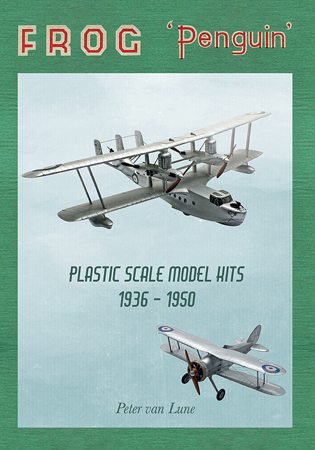Frog Penguin Model Kits, 1936-50
Frog was one of the first manufacturers of all plastic model kits in the world, pre-dating most U.S. companies by almost 20 years. Unlike other manufacturers, they did not start off building toys or other items, but rather their first product was the “Interceptor”, a rubber band powered model aircraft. It was distinguished by two things. One is that when those gliders you knew as a kid were being made of balsa wood, the Interceptor was metal. The other is that you did not launch it or throw it, it took off from the ground. Mr. van Lune goes into an extensive discussion of this aspect as it led to the company’s name, FROG, which in various legends came from Flies Right Off the Ground.
Mr. van Lune is obviously devoted to Frog model kits and in this case the Penguin line of Frog kits. He has done meticulous research and has an extensive personal collection of Frog kits as well, so he knows that of which he speaks.
The book focuses on the history of the Penguin line of kits from Frog. These were what were known as non-flying, or static, models. Frog gave them a different name to distinguish them from their line of flying models, so the non-flying models got the name of a non-flying bird. Mr. van Lune goes into some detail as to how this line came about, how it came to be made out of what was then termed “plastic” and how they were marketed and sold. As a matter of fact, this is a gold mine of old photos of Frog kits, adverts and other ephemera. It is written in an informal almost conversational style.
One criticism is that the story in some spots is sometimes difficult to follow due to how the book is laid out. The main text in many places is secondary to a plethora of sidebars and illustrations that may or may not correspond to what is being discussed in the text. But this may be a bit picky as the information in those sidebars supplements the text and adds depth to his coverage.
There are other books on the history of the Frog line of kits, but not one that focuses on these pioneering kits. Frog stopped making its Penguin line in 1950, so only the more senior members of our society could have had first-hand experience of them, but anyone interested in the history of our hobby or is a kit collector as a complete list of the Penguin line kits is included, will find this book interesting and valuable.
Thanks to Mr. van Lune for providing a copy and to IPMS/USA for the opportunity to review it.







Comments
Add new comment
This site is protected by reCAPTCHA and the Google Privacy Policy and Terms of Service apply.
Similar Reviews